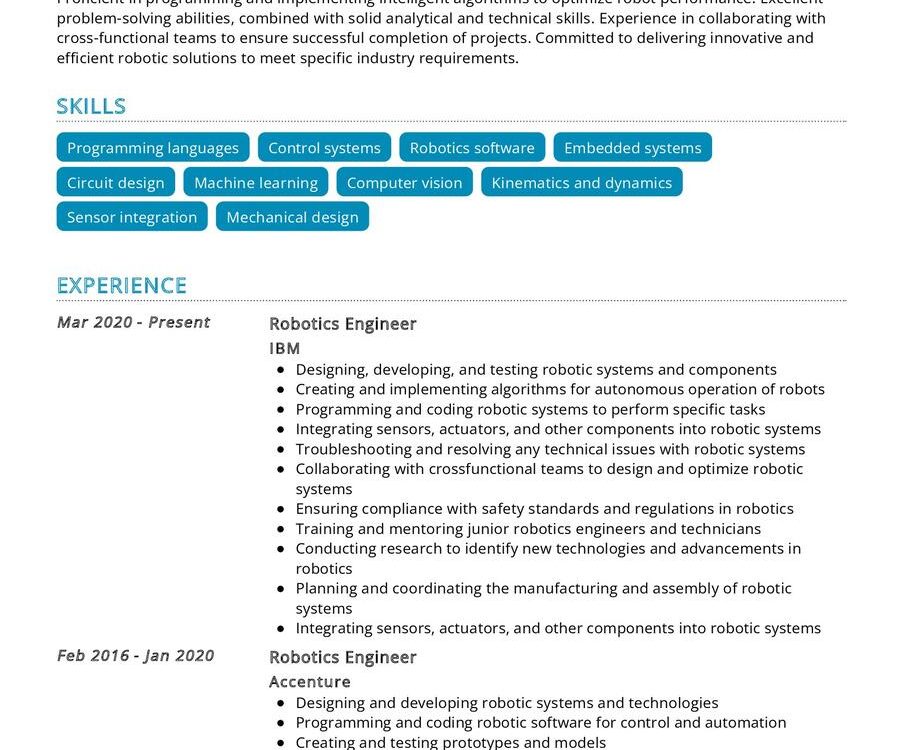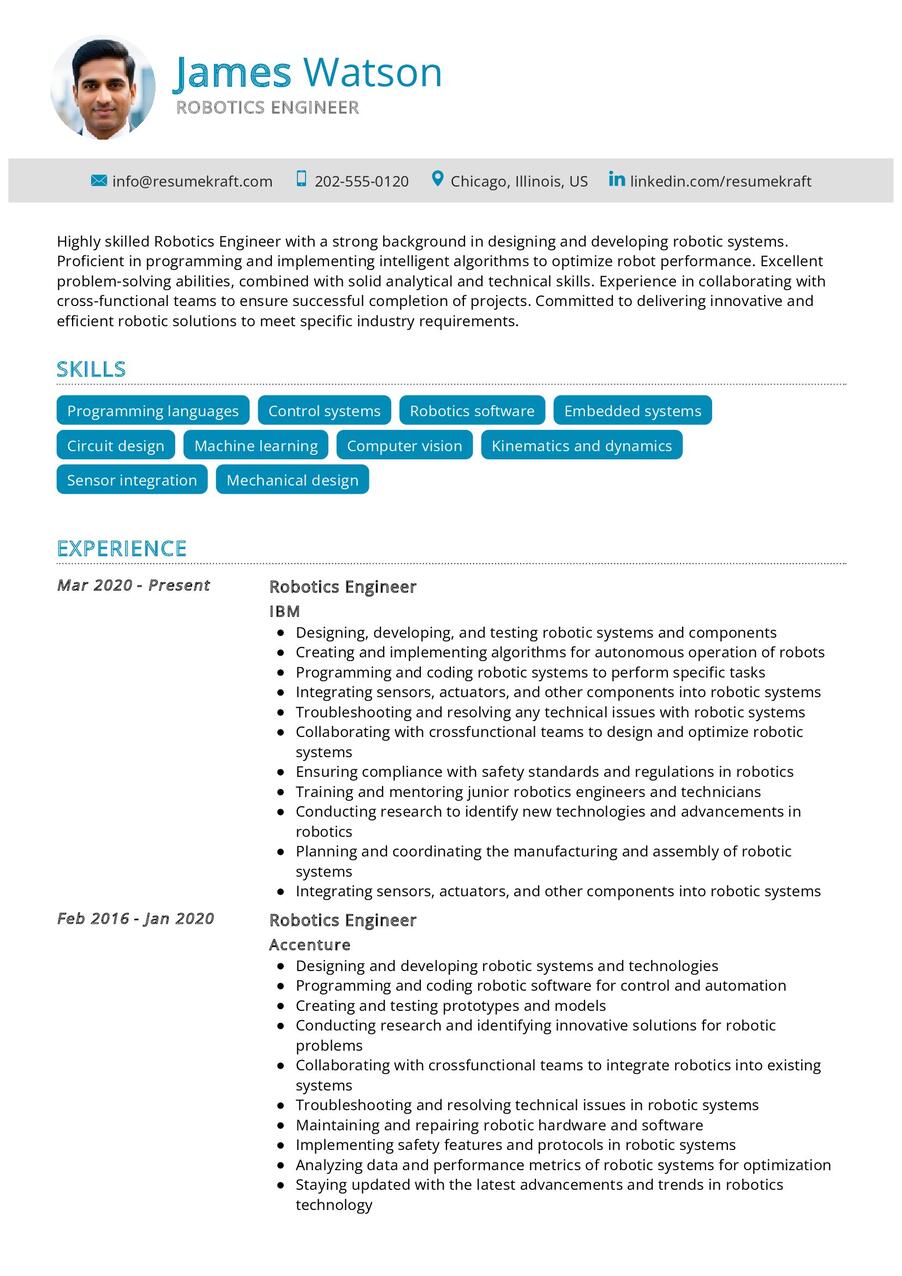Exploring the Role of a Robotics Engineer
In the rapidly advancing field of robotics, the role of a Robotics Engineer holds significant importance. This article delves into the multifaceted responsibilities and requirements that define the position, emphasizing the blend of technical expertise and innovation required in this dynamic field.
Key Responsibilities of a Robotics Engineer
A Robotics Engineer plays a pivotal role in designing, developing, and maintaining robotic systems. This involves a range of tasks, including:
- Designing robotic systems tailored to specific applications, considering factors such as functionality and efficiency.
- Programming and coding robotic systems to perform tasks autonomously or under human supervision.
- Testing and troubleshooting robotic systems to ensure optimal performance and identifying areas for improvement.
- Collaborating with cross-functional teams to integrate robotics into various industries, from manufacturing to healthcare.
- Staying abreast of technological advancements in robotics and incorporating innovative solutions into existing systems.
- Ensuring compliance with safety standards and regulations in the development and deployment of robotic systems.
The role of a Robotics Engineer is dynamic, requiring adaptability and continuous learning to keep up with the evolving landscape of robotics technology.
Requirements for a Robotics Engineer Position
Stepping into the role of a Robotics Engineer necessitates meeting specific requirements. Below are the key qualifications and skills sought after by employers:
- A Bachelor’s or Master’s degree in Robotics Engineering, Mechanical Engineering, Electrical Engineering, or a related field.
- Proficiency in programming languages such as C++, Python, or Java, crucial for coding and developing robotic systems.
- Hands-on experience with robotic simulation software and hardware, showcasing practical application of theoretical knowledge.
- Strong analytical and problem-solving skills, essential for identifying and resolving issues in robotic systems.
- Excellent communication skills to collaborate with diverse teams and convey complex technical concepts to non-technical stakeholders.
- Adaptability and a passion for staying updated on the latest trends and advancements in robotics technology.
Additional certifications in robotics or related fields can enhance your profile in the competitive job market.
Crafting a Robotics Engineer Resume
When creating your resume for a Robotics Engineer position, consider the following tips to make it stand out:
- Highlight your experience in designing and implementing robotic systems, specifying the industries and applications involved.
- Showcase successful projects by detailing the impact of your work on the efficiency and functionality of robotic systems.
- Quantify achievements where possible, using metrics to demonstrate the outcomes of your contributions.
- List relevant certifications and ongoing learning initiatives, emphasizing your commitment to staying current in the field.
- Customize your resume for each application, aligning your skills and experiences with the specific job requirements.
Your resume should not merely be a document but a narrative of your journey and accomplishments as a Robotics Engineer.
Robotics Engineer Resume Summary Examples
Your resume summary is a crucial snapshot of your career. Here are examples that encapsulate your experience and value as a Robotics Engineer:
- “Robotics Engineer with a Master’s in Robotics Engineering, adept at designing and implementing innovative robotic systems for manufacturing applications.”
- “Experienced Robotics Engineer specializing in autonomous navigation systems, contributing to the advancement of robotics in the healthcare sector.”
- “Results-driven Robotics Engineer with a proven track record in optimizing robotic processes, enhancing efficiency in diverse industrial settings.”
Your resume summary should entice potential employers, giving them a glimpse of your expertise and achievements in the field of robotics.
Building the Experience Section of Your Robotics Engineer Resume
The experience section is the heart of your resume, providing a detailed account of your career journey. Here are examples to guide you:
- “Led a team in the development of a robotic assembly line, reducing production time by 30% and improving overall efficiency.”
- “Designed and implemented a robotic surgical system, contributing to precise and minimally invasive procedures in the medical field.”
- “Collaborated with software engineers to enhance the AI capabilities of robotic systems, resulting in more adaptive and responsive machines.”
Your experience section should narrate the story of your career, emphasizing the challenges you’ve overcome and the successes you’ve achieved as a Robotics Engineer.
Education Section for Your Robotics Engineer Resume
Highlight your educational background to showcase your foundation in robotics and engineering:
- Master of Science in Robotics Engineering, XYZ University, 2019.
- Bachelor of Science in Mechanical Engineering, ABC University, 2017.
- Certified Robotics Professional (CRP), demonstrating expertise in the field, 2020.
Your education section should affirm your knowledge base and commitment to excellence in the field of robotics.
Skills Essential for a Robotics Engineer Resume
As a Robotics Engineer, your skill set is your toolkit. Here are the essential skills, both soft and hard, that employers seek:
Soft Skills:
- Problem-solving and analytical thinking, essential for troubleshooting and optimizing robotic systems.
- Communication and collaboration skills, crucial for working effectively with interdisciplinary teams.
- Adaptability and continuous learning, given the dynamic nature of robotics technology.
- Attention to detail, ensuring precision in the design and execution of robotic systems.
- Innovation and creativity, driving the development of cutting-edge robotic solutions.
Hard Skills:
- Proficiency in programming languages such as C++, Python, or Java.
- Experience with robotic simulation software and hardware.
- Knowledge of robotic control systems and artificial intelligence (AI) applications.
- Understanding of mechanical and electrical engineering principles.
- Familiarity with safety standards and regulations in the robotics industry.
Each skill is a tool in your arsenal, contributing to your effectiveness as a Robotics Engineer.
Common Mistakes to Avoid in Your Robotics Engineer Resume
Steer clear of common pitfalls when crafting your Robotics Engineer resume. Here are some mistakes to avoid:
- Avoid using generic terms; tailor your resume to showcase your unique strengths and experiences.
- Focus on achievements rather than just listing job duties, providing depth to your narrative.
- Include a well-crafted cover letter to complement your resume and convey your passion for robotics engineering.
- Balance technical jargon; ensure your resume is accessible to both technical and non-technical readers.
- Thoroughly proofread your resume to maintain a polished and professional image.
Avoiding these mistakes ensures your resume effectively communicates your value as a Robotics Engineer.
Key Takeaways for Your Robotics Engineer Resume
As you craft your Robotics Engineer resume, keep these key points in mind:
- Highlight your expertise in designing and implementing robotic systems for specific applications.
- Showcase the impact of your work on efficiency, functionality, and advancements in the field of robotics.
- Quantify achievements using metrics to demonstrate the outcomes of your contributions.
- Emphasize ongoing learning initiatives and relevant certifications to exhibit your commitment to staying current in the field.
Your resume should be a compelling narrative of your journey, skills, and aspirations as a Robotics Engineer. Best of luck!
Finally, feel free to utilize resources like AI Resume Builder, Resume Design, Resume Samples, Resume Examples, Resume Skills, Resume Help, Resume Synonyms, and Job Responsibilities to create a standout application and prepare for the Robotics Engineer job interview questions.


